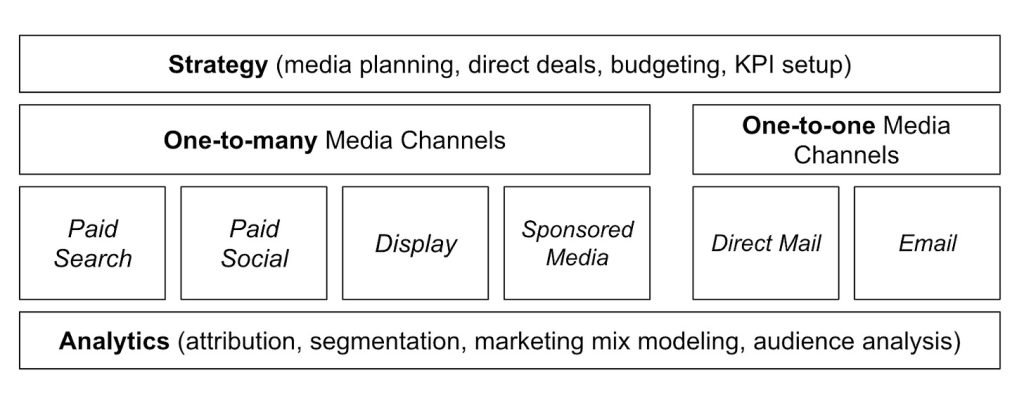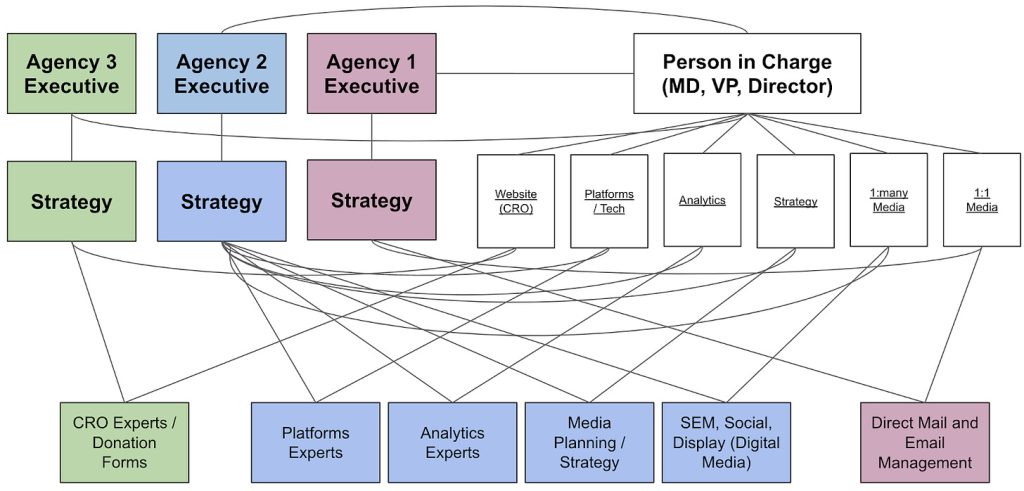
The Ideal Team Composition: Agency – In-House
First off you need to have Google Analytics in place – tracking and measurement are key. I should start every conversation like this!
One person juggling marketing and fundraising at even the smallest Org can unleash several Google Ads campaigns. But in order to scale, you need a team to carry you through quick emergency launches, up-and-down holiday season scaling, and the adoption of new platforms.
Before determining who you need on the team – and definitely before deciding what to in-house versus outsource – look at the functions your Org would need as it develops a successful digital fundraising machine. Here is the minimum set I consider viable:

The above set of functions doesn’t have to be implemented all at once – but as your program grows, each building block will prove necessary to integrate your donor data, understand the best donor profile, find more donors of that same profile, efficiently buy media against them, and measure the results to readjust.
The above functional chart can be translated to the following Org:

Ideally every box above should be at least one person, with teams growing underneath them as the budget allows. That said, this can be streamlined a little and I’m happy to chat about how.
But now, when – and what – to outsource?
I’m certain – and suggest to everybody – that it helps to outsource the skills but you should in-house or ideally “double-source” the strategy and knowledge.
In general I think the non-profit vertical, unfortunately, is under-served within the agency world. Budgets are marginal compared to the large Fortune 500 for-profit businesses. I’ve sat in too many meetings with Holding Company agencies (think Group M, Grey, VMLY&R, Wunderman – they all sit under the holding of WPP) who present an all-singing, all-dancing strategy, often with promises of inventory in the CMO of CDO’s favorite podcast/magazine…etc.
What determines performance is not inventory.
It’s the people managing it. And in my experience, going the HoldCo route has led to working with the C team. Not always. But most of the time. People are either rotating through or rotating out, working on non-profits for short periods of time while they’re on the bench.
Caveat: There’s a strong case to be made for working with agencies who do not sit under a Holding Company model. For starters there’s nowhere to hide for bad performance.
HoldCo’s will also usually manage your campaigns in a black box, sparing you the knowledge of what truly works and what doesn’t. That makes you depend on them and go at their pace, not yours. No thank you.
And smaller agencies?
Those usually lack the complete knowledge of how integrated performance is to brand growth or relevance, and vice versa. They’re often specialists who don’t provide a holistic service. Managing a set of smaller vendors requires lots of business context, and that can’t be acquired outside – it needs to be in-house.
Hence my ideal Agency <> In-House team mix over the years developed to be this:

While it looks like an eye sore (and actually looked way better on the back of a napkin!) it’s my way of sketching out how integrated our functions needed to be with in-house practitioners, our agency partners and our day-to-day leadership across digital. The more lines the more integration!
Key take-away 1
Agencies report into the person in charge of day-to-day execution: I always wanted to have direct contact with the Executive-level of my agency partners to a) be able to hold them accountable but b) bounce off ideas and directly learn from them.
Key take-away 2
Strategy-level thinking should be “double-sourced” to both retain institutional knowledge in-house (white boxes, Strategy line) and be able to tap into the wider industry picture.
Key take-away 3
Skills can be outsourced to agencies (bottom line) as long as their homework is graded in-house (white boxes, Strategy line). I always had the Analytics person sitting on my team so we had full visibility and complete understanding of campaign (and agency) performance.
Don’t Overly Fragment
A question I often hear is “why 3 agencies, not 6?”
3 isn’t the magic number – it can be 4, or 5, or even 6. But in my experience, the three main distinct areas connected to digital fundraising are “Website”, “Performance Media” and “1:1 Media”. Performance media usually encompasses all those 1-to-many channels. The results just seem to be better when I’m not overly fragmenting my outside partners’ roaster. I also might have been lucky.
Assembling the team is important – yet the real magic happens after contracts are signed. I thoroughly – VERY thoroughly – vet my partners upfront. But when it’s signed, they are my team – and I treat them as such. Don’t treat them as vendors – treat them as partners, and request they do the same amongst each other.
Maybe they’ll be frenemies for a moment – it’s an unnatural behavior for most agencies to collaborate – but the results that have been driven because of such collaborations leave me in no doubt that there’s only one way to operate.
Inter-Agency Collaboration
Here’s a few ideas on how to promote some inter-agency collaboration and joint responsibility – we’ll dig deeper into some of them in future editions of SPN:
- Cross-channel revenue as the main KPI for every agency to tie them at the hip
- Daily meetings during heavy fundraising times (emergency, end of year fundraising) with your team sharing out agency numbers with everybody
- Shared audiences and tests for two-dimensional media
- Weekly all-agency calls with a specific agenda and rotating accountability for follow-ups to incorporate collaboration
- More human activities – in-person all-agency QBRs and get togethers
Some of my most rewarding experiences in professional life have come from operating alongside agency partners and bringing them into my teams. I’ve benefited enormously from their counsel and their abilities to get stuff done fast and they’ve been fantastic sources of learning & development. There’s a time and a place for agencies. But in all cases, strategy must be built in-house and you need in-house eyes on the analytics.